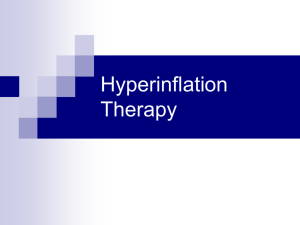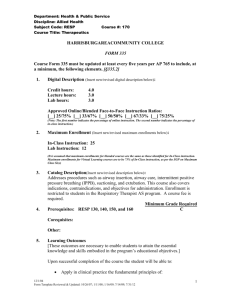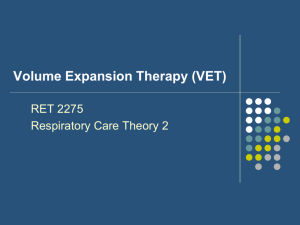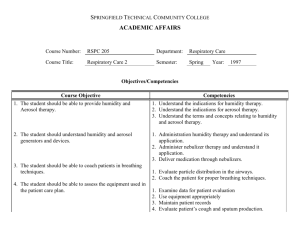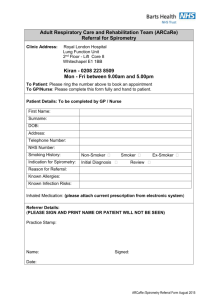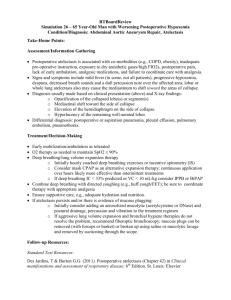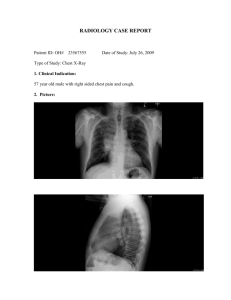Hyperinflation Therapy
advertisement
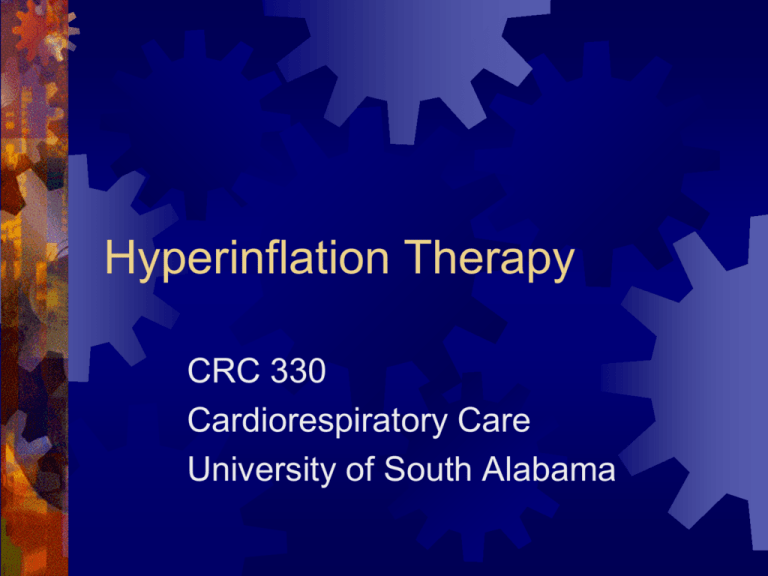
Hyperinflation Therapy CRC 330 Cardiorespiratory Care University of South Alabama Hyperinflation Therapy Atelectasis Incentive Spirometry Positive Expiratory Pressure Intrapulmonary Percussive Ventilation Continuous Positive Airway Pressure Atelectasis Greek for “without air” Susceptible patients Postoperative or debilitated patients Patients who won’t or can’t take a deep breath Patients with retained secretions or mucus plugging Resorption Atelectasis Obstruction of the bronchus by tumor, mucus, foreign body, or contralateral ETT Oxygen distal to the obstruction diffuses into the pulmonary blood Alveoli shrink and collapse More pronounced when the FiO2 is high Therapy is directed at the cause Passive Atelectasis Failure of ability to intermittently stretch alveoli by deep breathing, sighing, or yawning Alveoli shrink, and eventually collapse Most often seen in patients postoperatively Repositioning, deep breathing, IS, IPPB Tailor therapy to patient’s abilities Who needs lung expansion therapy? Neuromuscular disease (myasthenia gravis, Guillian-Barre syndrome, muscular dystrophy) Heavy sedation (narcotics, barbiturates, anesthetics) Upper abdominal or thoracic surgery (risk increases closer to the diaphragm) Spinal cord injury (due to trauma) Being bedridden or immobile (stroke, Alzheimer’s disease, coma) Abnormal preoperative spirometry The particular risk for postoperative patients General anesthesia, Smoking and abnormal spirometry, Rapid shallow breathing due to pain, Transient decrease in surfactant production all lead to decreased FRC Dependent lung segments, decreased V/Q, hypoxemia The particular risk for postoperative patients Splinting and decreased Vt Impaired cough and mucociliary escalator leads to inspissation and plugging Hyperinflation therapy Improves tracheobronchial hygiene Facilitates cough Prevents atelectasis Symptoms of atelectasis Rapid shallow breathing Increased tactile fremitus Dullness to percussion Fine, late inspiratory crackles, bronchial or decreased breath sounds Abnormal voice sounds Tachycardia and fever Hypoxemia Symptoms of atelectasis: CXR Increased opacity Plate atelectasis Fissure displacement Crowding of pulmonary vasculature Air bronchograms Elevation of adjacent diaphragm Narrowed rib interspaces Mediastinal/tracheal shift Compensatory hyperexpansion of surrounding lung Physiologic Basis of Hyperinflation Therapy Facilitate lung expansion by increasing the transpulmonary pressure gradient (PL) PL=Palv-Ppl Decrease the Ppl (IS) or increase the Palv (IPPB, PEP, CPAP, IPV) Decreasing the Ppl is more physiologic because it's the same as normal breathing Incentive Spirometry Inspiration of a predetermined volume or flow, for as long as the patient can, followed by an inspiratory pause of > 3 sec from resting level up to inspiratory capacity mimics natural sigh or yawn sighing is the natural method to avoid atelectasis, which is lost in the postoperative period Increases the PL by decreasing the Ppl below that normally achieved Goals/Outcomes of Incentive Spirometry Absence of or improvement in signs of atelectasis Improved VS Normalization of BS Improved radiograph Improved SpO2, PaO2 and PaCO2 Restoration of preoperative volumes Improved inspiratory muscle performance Incentive Spirometry Indications conditions predisposing to atelectasis upper abdominal and thoracic surgery, patients with COPD who will have surgery presence of atelectasis restrictive lung defect associated with neuromuscular dysfunction Incentive Spirometry Hazards correctly performed IS has few, if any don't interrupt oxygen therapy don't allow patient to perform too fast Dizziness Discomfort secondary to inadequate pain control Exacerbation of bronchospasm Fatigue Incentive Spirometry Indirectly indicate volume based on flow through a fixed orifice Not precisely accurate, but adequate Indicator set to goal Goal=volume from included nomogram Incentive Spirometry Volume oriented spirometer Bellows displacement Actually measures volume Usually larger May be more expensive Incentive Spirometry Planning identify explicit goals based on patient ability baseline assessment should include all patients scheduled for upper abdominal and thoracic surgery determine preop IC as postop goal, using the chart included with the IS if postop VC is < 12-15 cc/kg, or the IC is < 1/3 predicted, consider IPPB if the patient is uncooperative. obtunded, unconscious, IS is not possible: use IPPB or CPAP Incentive Spirometry Implementation goal should be obtainable, but require moderate effort (no pain no gain) inhale slowly and deeply breath-hold for 5 sec may be necessary to rest 30-60 sec to avoid hyperventilation 8-10 maneuvers/hour; this mimics the normal sigh Incentive Spirometry Follow up/monitoring Frequency of sessions Number of breaths/session Volume goal achieved Breath hold maintained Effort Periodic observation of compliance Keep IS within reach VS/BS Intermittent Positive Pressure Breathing (IPPB) Application of inspiratory positive pressure With aerosol therapy (usually a bronchodilator) Spontaneously-breathing patient, short time (1520 min) Q1 hour to 3-4x daily A history shrouded in controversy Increases PL and therefore lung volume by increasing Palv Not the first-choice when other therapy is cheaper Can be volume or pressure oriented Indications for IPPB Clinically diagnosed atelectasis not responsive to other therapies Patients at high risk for atelectasis Delivery of aerosol if SVN therapy is ineffective IPPB Hazards Increased airway resistance Pulmonary barotrauma Nosocomial infection Respiratory alkalemia Hyperoxia Decreased venous return Gastric distention Air trapping Psychological dependence IPPB: Contraindications Tension pneumothorax ICP>15mmHg Hemodynamic instability Active hemoptysis Tracheoespohageal fistula Recent esophageal, facial, skull, or oral surgery Active, untreated TB Radiographic evidence of blebs Singulitus Air swallowing, nausea IPPB ventilator: Bird Mark 7 Pneumatically powered Pressure controlled Pressure triggered Pressure cycled Flow or pressure limited Must measure exhaled volumes Mark 7 Mark 7A IPPB: Administration Planning Determine need and desired outcomes Must be measureable IC 70% predicted Improved radiograph Improved BS Decreased f Simpler method effective? Baseline evaluation VS, appearance and sensorium, breathing pattern, auscultation IPPB: Administration Implementation Equipment preparation Patient orientation Assure correct function of the ventilator and circuit Explain purpose Why ordered, what treatment does, how it will feel, outcomes Simulated demonstration with a test lung Patient positioning IPPB Administration Initial application Nose clip or lip seal may be necessary Insert mouthpiece beyond lips, tight seal Mask for alert and cooperative patients only, who leak with a mouthpiece Sensitivity: -1 to -2 cm H2O Pressure 10-15 cm H2O, measure volume Mid-flow range 6 bpm, I:E of 1:3 to 1:4 IPPB Administration Adjusting parameters Adjust pressure to achieve volume goal (70% of predicted IC or 10-15 mL/kg) Patient should breathe actively IPPB Monitoring and Troubleshooting Machine performance Negative pressure swings at initiation of inspiration Ti too long or short Linked tubing or mouthpiece obstruction Leaks IPPB Monitoring and Troubleshooting Patient Response Breathing rate and expiratory volume VS and BS Sputum characteristics Sensorium ICP Radiograph Subjective response IPPB: Infection control New circuit every day Standard precautions Assure cleanliness of nebulizer, don't rinse in tap water Airway Pressure Adjuncts Primarily for Treatment of Atelectasis and Secondarily for Retained Secretions CPAP PEP IPV CPAP Patient breathes from a pressurized circuit against a threshold resistor 5-20 cm H2O Gas flow is high enough to keep pressure positive throughout I and E Pressure is increased until PaO2 responds, then FiO2 is decreased Treatments or continuous CPAP Circuit PEP Patient exhales against a fixed orifice resistor 10-20 cmH2O Done as a treatment Includes Flutter and Acapella Vibratory PEP - Acapella Airway Pressure Adjuncts Indications reduce air trapping by providing an opposing pressure, splinting the airways open aid in mobilization of retained secretions prevent/reverse atelectasis optimize delivery of bronchodilators Airway Pressure Adjuncts Contraindications patients unable to tolerate the increased WOB increased ICP hemodynamic instability recent oral, facial or skull surgery or trauma acute sinusitis Airway Pressure Adjuncts Hazards/complications increased WOB increased ICP cardiovascular compromise air swallowing claustrophobia mask trauma pulmonary barotrauma system leakage Airway Pressure Adjuncts Assessment of need sputum retention not responsive to spontaneous or directed coughing decreased/adventitious breath sounds tachypnea, tachycardia atelectasis, mucous plugging, infiltrates on CXR hypoxemia, desaturation Airway Pressure Adjuncts Assessment of change outcome in sputum production: if it does not increase with PEP, then PEP is not indicated breath sounds should clear vital signs should improve radiograph should improve ABGs or sat should improve Airway Pressure Adjuncts Equipment PEP: PEP device with fixed orificial resistor and manometer Airway Pressure Adjuncts EZ PAP Gas powered PEP system Airway Pressure Adjuncts Monitoring patient’s subjective response to therapy pulse rate and ECG breathing pattern and rate sputum production skin color breath sounds blood pressure pulse oximetry/ABGs ICP if applicable Airway Pressure Adjuncts Frequency in the ICU, q 1-6 hours, especially for CPAP to treat atelectasis otherwise 2-4 times daily depending on patient response reevaluate every 72 hours Intrapulmonary Percussive Ventilation (IPV) IPV ventilator creates a pneumatic oscillation of 100-225 cycles per minute (1.6-3.75 Hz) during inspiration or both inspiration and expiration Purpose oscillation is designed to open atelectatic areas, force air behind mucus obstructions, and promote mucus clearance IPV IPV IPV Patient Interface IPV Research on this method is scarce IPV is as effective as postural drainage and percussion in promoting mucus clearance in cystic fibrosis patients. Anecdotal reports are encouraging regarding the treatment of atelectasis where IPV may be more effective than other methods. Selecting an approach Key Factors Recommended techniques for specific conditions Example algorithm
